OSG(美国海军NPS)教程学习加实践(2)
GMDSS实习报告

GMDSS实习报告保障海上人命安全,是保证海上安全中最根本的。
只有拥有一套在所有海区提供有效的通讯手段,完善的搜寻救助体制式等组成的系统才能真正有效的保障海上人命安全。
GMDSS便是这样的一套系统。
上船一年多来,在本船GMDSS操作员的指导下我通过对本船GMDSS 设备的操作、测试,以及理论业务的学习,对GMDSS有了更进一步的直观的了解,掌握了本船设备的基本操作。
GMDSS即GLOBAL MARITIME DISTRESS AND SAFETY SYSTEM全球海上遇险和安全系统,它是陆上的搜寻救助机构和航行在遇险船舶周围的船只将迅速的得到关于遇难事件的报警,以便他们能在最短的延迟时间内提供协调搜寻和救助行动的系统。
这个系统同时提供紧急和安全通信,并能向船舶播发海上安全信息(MSI)――航行和气象警告、气象预报及其它紧急安全信息。
换言之不管船舶航行在哪个区域,每条船都能够履行对本船和同一海域其他船舶安全都很重要的一切通信任务。
由于GMDSS中无线电分系统各自的地理覆盖区和所提供的业务不同,船舶配备设备原则上由船舶所航行的区域决定。
GMDSS的海区规定如下:A1海区-至少有一个VHF岸台的无线电话覆盖的区域,在该区域内能提供连续有效数字选择性呼叫报警,这个区域可由缔约国政府规定;A2海区-A1海区除外,至少有一个MF岸台的无线电话覆盖的区域,在该区域内能提供连续有效的数字选择性呼叫报警,这个区域可由缔约国政府规定;A3海区-A1和A2海区除外,在INMARSAT静止卫星的覆盖范围内,能提供连续有效的报警的区域;A4海区-A1、A2和A3海区以外的剩余海区。
GMDSS的通信功能:(1)报警。
遇险报警是向能提供协调援助的单位迅速成功的报告遇难事件,并提供遇难资料,如遇难船舶的识别、地理位置以及事故的性质和其他可能有利于救助行动的信息。
GMDSS的通信设施安排是能使遇险报警信息沿三个方向传送的:船到岸,船到船,岸到船,即向所有海区发出遇险报警信号。
PAGOPAGO港美国海岸警备队PSC检查实例汇编

美国海岸警备队检查船舶实例船长:徐仕军2007年3月29日Vessel’s Name: Fortuna ReeferPort: Pago Pago, American SamoaDate: Mar. 29, 2007Type of Vessel : Reefer carrierPSC检查官上船前一天通知代理告知船舶做好接受检查准备(PSCO一般会在上船前一天通知代理)。
1030L ,海岸警备队 2 名检查官对船舶进行检查。
PSCO 刚到船长房间就告诉船长检查顺序:将在驾驶台和船首各准备一根皮龙,将试验出水压力等情况,等机舱检查后将进行演习,首先厨房失火演习,然后弃船演习。
一名官员(职位高的一位)下机舱检查,另一名官员在船长房间,首先问 SSO 几条关于保安方面的问题。
船长安排二副和三副在驾驶台待命,各持对讲器并与船长大副保持有效联络,大副在船长房间接受PSC 官员询问,老轨带领全部轮机员以及电机员、冷藏员随检查官进入机舱接受检查。
其他船员全部穿好工作服在船待命。
问 SSO 的问题如下:1.船上是否有保安报警系统,几个位置有?(他只要求告诉在驾驶台有一个,另一个地方不要求告诉他);2.公司保安员是谁,是否有与其保持24 小时联系方式?3.当你发现一个可疑包裹时如何处理?4.当你发现一个偷渡者时如何处理?(回答中不能忽视要给偷渡者适当的食物和水);5.当港口保安等级为 2,你船为 1时,你如何处理?6.你的保安计划是如何保管的,是否上锁保管?其他(省略)。
PSCO 是在一本检查目录上以随机抽查形式提问的,因此,在每条船检查时提问什么问题可能有较大差异。
接着问船长关于保安方面几个问题后开始检查船舶证件、美国非油轮船舶反应计划、船员适任证书以及救生筏证书。
丰群代表阎璘随PSCO 下机舱陪同并在适当时给予解释或翻译,另一名新来的丰群代表唐宇在船长房间,适当时候也可以给予翻译,他们都是大学外语专业(英语)毕业生,曾多次参与该港口 PSC 检查现场协调工作,有一定的经验。
基于OpenSceneGraph(OSG)的虚拟小区漫游系统
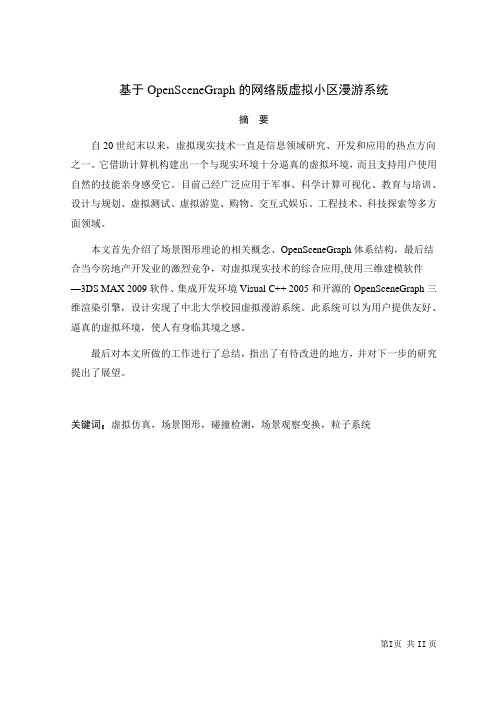
基于OpenSceneGraph的网络版虚拟小区漫游系统摘要自20世纪末以来,虚拟现实技术一直是信息领域研究、开发和应用的热点方向之一。
它借助计算机构建出一个与现实环境十分逼真的虚拟环境,而且支持用户使用自然的技能亲身感受它。
目前己经广泛应用于军事、科学计算可视化、教育与培训、设计与规划、虚拟测试、虚拟游览、购物、交互式娱乐、工程技术、科技探索等多方面领域。
本文首先介绍了场景图形理论的相关概念、OpenSceneGraph体系结构,最后结合当今房地产开发业的激烈竞争,对虚拟现实技术的综合应用,使用三维建模软件—3DS MAX 2009软件、集成开发环境Visual C++ 2005和开源的OpenSceneGraph三维渲染引擎,设计实现了中北大学校园虚拟漫游系统。
此系统可以为用户提供友好、逼真的虚拟环境,使人有身临其境之感。
最后对本文所做的工作进行了总结,指出了有待改进的地方,并对下一步的研究提出了展望。
关键词:虚拟仿真,场景图形,碰撞检测,场景观察变换,粒子系统Virtual Community of Roaming System Online Based onOpenSceneGraph EngineAbstractSince the late 20th century, Virtual reality has been the field of information technology research, development and application of one of the hot direction.It is constructed using the computer a very realistic virtual reality environment, but the skills to support users to experience it naturally.Now has been widely used in military, scientific visualization, education and training, design, and planning, virtual testing, virtual tours, shopping, interactive entertainment, engineering technology, such as many areas of science and technology exploration.This paper introduces the concept of scene graph theory related, OpenSceneGraph architecture, Finally, today's real estate development industry, intense competition, the integrated application of virtual reality technology, using 3D modeling software-3DS MAX 2009 software, integrated development environment, Visual C + + 2005 and the open source OpenSceneGraph 3D rendering engine, designed and implemented in the North Campus Virtual Tour System. This system could provide users with friendly, realistic virtual environment, giving the feeling.Finally, this article summarizes the work done, pointed out the areas to be improved, and the future study are pointed out.Keywords:Virtual Reality, Scene Graph, Collision Detection, Scene Observed Transformation, Particle System目录1 绪论 (1)1.1 背景及意义 (1)1.2 虚拟仿真视景技术的发展状况和趋势 (1)1.3 本文的组织结构 (3)2 场景图形理论 (5)2.1 场景图形的概念 (5)2.2 场景图形的特性 (7)2.3 场景图形的渲染方式 (8)2.4 本章小结 (9)3 基于OpenSceneGraph的虚拟系统开发工具和环境简介 (10)3.1 OpenSceneGraph三维渲染引擎 (10)3.1.1 OpenSceneGraph的发展状况 (11)3.1.2 OpenSceneGraph的结构 (12)3.2 3DS MAX 2009简介 (15)3.3 Visual C++ 2005简介 (16)3.4 C++语言简介 (16)3.5 基于OpenSceneGraph的虚拟系统开发环境 (17)3.6 其它相关工具 (17)3.7 本章小结 (17)4 基于OpenSceneGraph的网络版虚拟小区漫游系统的开发 (18)4.1 系统的需求分析 (18)4.2 系统的主要功能 (18)4.3 具体实现 (18)4.3.1小区模型的制作 (18)4.3.2 变换操作基础和场景观察 (19)4.3.3 漫游功能的实现 (23)4.3.4 碰撞检测 (26)4.3.5 喷泉的实现 (28)4.3.6 天空盒的实现 (32)4.3.7 导航器的实现 (34)4.4 系统测试 (36)4.5 本章小结 (40)5 总结与下一步展望 (41)5.1 全文总结 (41)5.2 下一步展望 (41)参考文献 (42)致谢 (43)1 绪论1.1 背景及意义随着社会的发展,科技的进步。
GMDSS培训教材
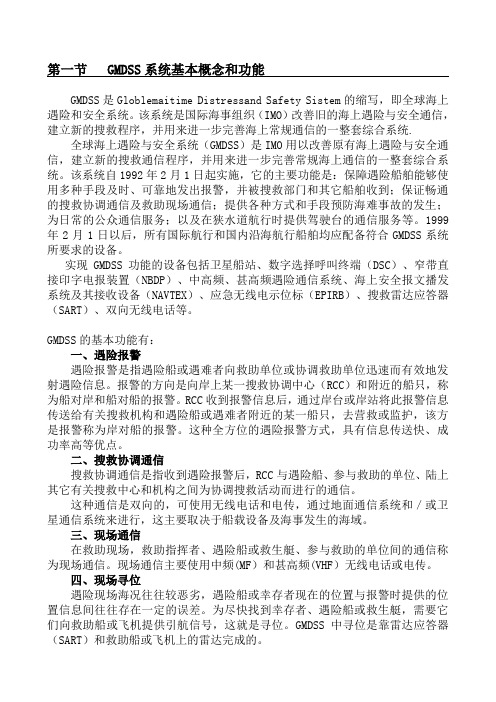
第一节 GMDSS系统基本概念和功能GMDSS是Globlemaitime Distressand Safety Sistem的缩写,即全球海上遇险和安全系统。
该系统是国际海事组织(IMO)改善旧的海上遇险与安全通信,建立新的搜救程序,并用来进一步完善海上常规通信的一整套综合系统.全球海上遇险与安全系统(GMDSS)是IMO用以改善原有海上遇险与安全通信,建立新的搜救通信程序,并用来进一步完善常规海上通信的一整套综合系统。
该系统自1992年2月1日起实施,它的主要功能是:保障遇险船舶能够使用多种手段及时、可靠地发出报警,并被搜救部门和其它船舶收到;保证畅通的搜救协调通信及救助现场通信;提供各种方式和手段预防海难事故的发生;为日常的公众通信服务;以及在狭水道航行时提供驾驶台的通信服务等。
1999年2月1日以后,所有国际航行和国内沿海航行船舶均应配备符合GMDSS系统所要求的设备。
实现GMDSS功能的设备包括卫星船站、数字选择呼叫终端(DSC)、窄带直接印字电报装置(NBDP)、中高频、甚高频遇险通信系统、海上安全报文播发系统及其接收设备(NAVTEX)、应急无线电示位标(EPIRB)、搜救雷达应答器(SART)、双向无线电话等。
GMDSS的基本功能有:一、遇险报警遇险报警是指遇险船或遇难者向救助单位或协调救助单位迅速而有效地发射遇险信息。
报警的方向是向岸上某一搜救协调中心(RCC)和附近的船只,称为船对岸和船对船的报警。
RCC收到报警信息后,通过岸台或岸站将此报警信息传送给有关搜救机构和遇险船或遇难者附近的某一船只,去营救或监护,该方是报警称为岸对船的报警。
这种全方位的遇险报警方式,具有信息传送快、成功率高等优点。
二、搜救协调通信搜救协调通信是指收到遇险报警后,RCC与遇险船、参与救助的单位、陆上其它有关搜救中心和机构之间为协调搜救活动而进行的通信。
这种通信是双向的,可使用无线电话和电传,通过地面通信系统和/或卫星通信系统来进行,这主要取决于船载设备及海事发生的海域。
GMDSS原理与操作

《GMDSS原理与操作》教学设计一、课程教学情况综述"全球海上遇险与安全系统(GMDSS)教学,是由多部分组成的理论与实践紧密结合的综合性教学课程。
该课程涉及海上通信英语(含听力、口语、专业英语阅读等)以及海事卫星通信系统、地面通信系统的原理与设备操作训练等。
该课程是航海院校根据国际海事组织(IMO)的有关国际公约和国家海事局对船员教育和培训的相关要求而设置。
青岛远洋船员学院的GMDSS教学在上世纪90年代前已经走在整个亚太地区的前列。
早在1990年,学院就建立了当时非常先进的GMDSS实训室,制定了GMDSS培训计划、大纲以及评估和考试要求,并完成了培训教材的编写工作,我院成为国家第一个开展GMDSS培训的航海院校,为中远集团以及山东省其他的航运企业培养了几百名学员,此项培训是在国家尚未实施船员GMDSS适任证书发放的情况下进行的,参加培训的学员考试合格后就可获得我院颁发的培训合格证书,该证书在当时情况下得到世界各国的认可。
正是这些学员,在国际航线的船舶营运中起到了关键的作用,为我国航运事业做出了自己的贡献,受到航运企业和相关行业的认可。
从1999年初开始,我院GMDSS培训进入大规模的培训阶段,至2001年底我院先后为中远集团举办了100多期驾驶员GMDSS、电子员等培训班,共培训船员超过5000人。
在此期间,学院作为辖区GMDSS唯一的培训单位,培训社会船员3000多人,圆满完成船员的GMDSS履约培训任务,满足了企业的用人需求,为中国远洋航运业输送了大批人材。
自2002年以来,海上通信取得长足的发展,电子和计算机技术在船舶得到广泛的应用;近几年来港口国监督检查(PSC)日益严格;国际国内海上通信法规也发生了很大变化;远洋船舶也按照国际有关组织的规定取消船舶专职通信人员,船舶通信工作由船舶驾驶员承担;这种形势下需要认真研究并对GMDSS教学进行改革。
作为早期GMDSS考试大纲与评估规范的起草单位之一,有必要在GMDSS教学改革方面先行一步。
美国海军声纳教程
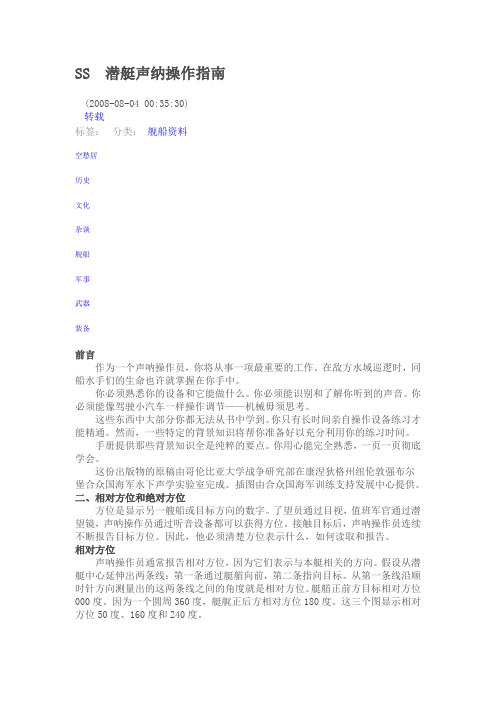
SS 潜艇声纳操作指南(2008-08-04 00:35:30)转载标签:分类:舰船资料空愁居历史文化杂谈舰船军事武器装备前言作为一个声呐操作员,你将从事一项最重要的工作。
在敌方水域巡逻时,同船水手们的生命也许就掌握在你手中。
你必须熟悉你的设备和它能做什么。
你必须能识别和了解你听到的声音。
你必须能像驾驶小汽车一样操作调节——机械毋须思考。
这些东西中大部分你都无法从书中学到。
你只有长时间亲自操作设备练习才能精通。
然而,一些特定的背景知识将帮你准备好以充分利用你的练习时间。
手册提供那些背景知识全是纯粹的要点。
你用心能完全熟悉,一页一页彻底学会。
这份出版物的原稿由哥伦比亚大学战争研究部在康涅狄格州纽伦敦强布尔堡合众国海军水下声学实验室完成。
插图由合众国海军训练支持发展中心提供。
二、相对方位和绝对方位方位是显示另一艘船或目标方向的数字。
了望员通过目视,值班军官通过潜望镜,声呐操作员通过听音设备都可以获得方位。
接触目标后,声呐操作员连续不断报告目标方位。
因此,他必须清楚方位表示什么,如何读取和报告。
相对方位声呐操作员通常报告相对方位,因为它们表示与本艇相关的方向。
假设从潜艇中心延伸出两条线:第一条通过艇艏向前,第二条指向目标。
从第一条线沿顺时针方向测量出的这两条线之间的角度就是相对方位。
艇艏正前方目标相对方位000度。
因为一个圆周360度,艇艉正后方相对方位180度。
这三个图显示相对方位50度、160度和240度。
绝对方位声呐操作员也可能被命令报告目标的绝对方位。
假设从潜艇中心延伸出两条线:第一条指向北极,第二条指向目标。
从第一条线沿顺时针方向测量出的它们之间的角度就是绝对方位。
无论潜艇航向多少,潜艇正北的目标绝对方位000度,正东绝对方位090度,正南绝对方位180度,正西绝对方位270度。
只有当本艇航向正北时,目标的相对方位和它的绝对方位才相同。
注意下图如何测量绝对方位。
读取方位指示器下面是一张方位指示器的图。
GMDSS实操训练手册及步骤
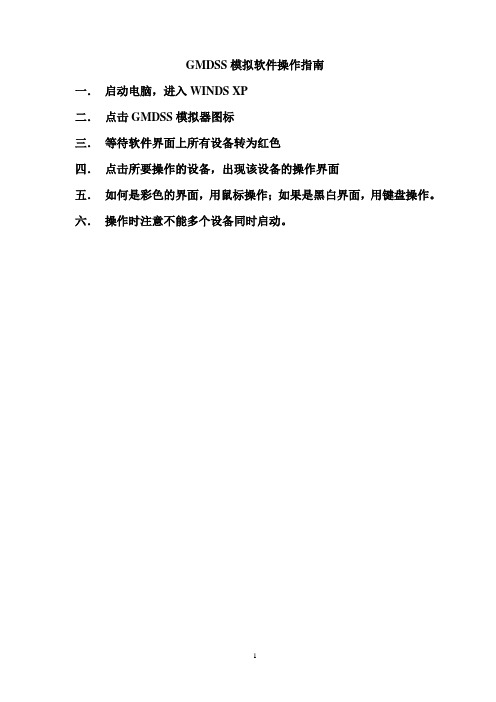
GMDSS模拟软件操作指南一.启动电脑,进入WINDS XP二.点击GMDSS模拟器图标三.等待软件界面上所有设备转为红色四.点击所要操作的设备,出现该设备的操作界面五.如何是彩色的界面,用鼠标操作;如果是黑白界面,用键盘操作。
六.操作时注意不能多个设备同时启动。
GMDSS智能评估系统考生端操作说明1.如何登陆系统:输入身份证号可进行考试登陆,登陆前,可点击录音按钮,对着麦克风说几句测试的话,点击停止按钮,再点击播放按钮,看看耳麦中是否有刚录到的语音,如果没有,请向监考官报告2.如何答题:看完题目后,点击“开始操作”按钮,开始进入实际答题,也可以点击“下一题”按钮,浏览整份试卷的题目,如题目未显示出来,可以点击“刷新”按钮,重新获取题目,请注意,屏幕的右上角有显示考试的剩余时间,大家操作过程中一定要注意这个时间3.如何答题:(1)进入实际操作后,当完成本题所有操作步骤后,请点击“结束操作”按钮,完成本题的操作(2)当该题操作完成后,题目的颜色将显示为绿色,如果想修改该题的操作步骤,请点击“重新操作”按钮,将重新进入到答题界面,考生可以重新将该题操作一遍(请记住,是删除所有的操作步骤,而不是某几步)4.如何回答口述题:考试的第四题是口述题,点击“开始操作”按钮,即可进入口述题回答界面(1).进入口述题界面后,首先点击“录音”按钮进行录音,确定回答完毕后,点击“停止”按钮,为了确保录音有效,请点击“播放”按钮进行聆听刚刚所录得语音答案(2).当确定录音成功后,请点击“发送语音答案”按钮,将回答的录音文件发送到服务器端,显示“发送成功”文字后,才表示答案语音已经发送成功,否则,请举手与监考官联系(3).当“第二步”显示“发送成功”后,点击“试听已经发送的语音”,在下方出现的播放器中,点击播放按钮,如能正常听到所回答的语音内容,则表示提交正确,否则请举手与监考官联系(4).当“第三步”操作完成并能听到正确语音后,点击“结束操作”按钮,完成本题回答,出现以下页面,如果确定所有题目回答完毕后,点击“结束考试”按钮,完成本场考试操作。
NPS操作流程指导书
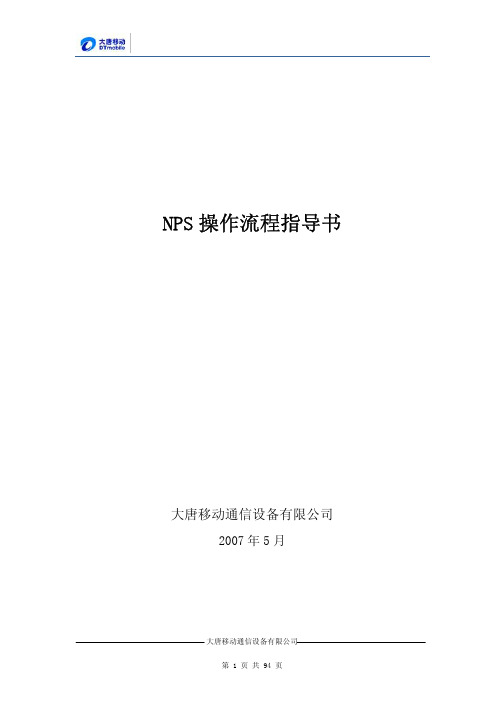
NPS操作流程指导书大唐移动通信设备有限公司2007年5月大唐移动通信设备有限公司目 录1 概述 (5)2 规划流程 (6)3 规划步骤 (8)3.1规划数据准备 (8)3.1.1 规划区的确定 (8)3.1.2 地理信息数据 (8)3.1.2.1 NPS支持的数字地图格式 (8)3.1.2.2 Planet格式数据转换 (9)3.1.2.3 MapInfo格式数据转换 (10)3.1.3 传播模型参数 (11)3.1.4 地物高度数据 (11)3.1.5 阴影衰落数据 (12)3.1.6 RNS数据 (12)3.1.7 可用载波数据 (12)3.1.8 天线数据 (12)3.1.9 业务数据 (13)3.1.10 UE数据 (14)3.2新建工程 (14)3.3模型校正 (15)3.3.1 编辑发射机参数 (15)3.3.2 导入实测数据 (16)3.3.3 通用模型参数校正 (17)3.4通过数据管理模块编辑数据 (18)3.4.1 编辑UE参数 (18)3.4.2 编辑业务数据 (19)3.4.2.1 编辑传输信道环境参数 (19)3.4.2.2 编辑承载参数 (19)3.4.2.3 编辑BLER曲线 (20)3.4.2.4 编辑业务参数 (21)3.4.2.5 编辑用户特性参数 (23)3.4.2.6 编辑用户分布参数 (23)3.4.3 编辑传播模型参数 (24)3.4.3.1 COST231-Hata经验传播模型 (24)3.4.3.2 COST231-WI经验传播模型 (25)3.4.3.3 通用传播模型 (27)3.4.3.4 标准微蜂窝模型 (31)3.4.4 设置地物高度 (34)3.4.5 编辑天线参数 (35)3.4.6 编辑载波参数 (37)3.5设置规划区 (37)大唐移动通信设备有限公司3.6创建RNS数据 (38)3.6.1 自动布站方式创建RNS (38)3.6.1.1 设置站址密度 (39)3.6.1.2 布站 (40)3.6.1.3 导入自动布站结果 (41)3.6.2 图形化编辑方式创建RNS (42)3.6.2.1 编辑RNS模板 (42)3.6.2.2 图形化编辑 (44)3.6.3 编辑RNS对话框方式创建RNS (44)3.6.3.1 编辑RNS参数 (44)3.6.4 导入RNS方式创建RNS (46)3.7设置扇区激活状态 (49)3.8设置业务密度 (49)3.8.1 创建业务密度图层 (50)3.8.1.1 新建业务密度图层 (50)3.8.1.2 导入业务密度图层 (51)3.8.1.3 导入现网业务数据 (53)3.8.2 编辑业务密度图层 (54)3.9传播预测 (56)3.9.1 传播预测具体实现 (56)3.9.2 传播预测结果 (57)3.10时隙比例规划 (58)3.11频率规划 (58)3.12邻区规划 (59)3.13码规划 (61)3.14设置仿真参数 (62)3.14.1 系统级仿真参数设置 (62)3.14.2 小区级仿真参数设置 (62)3.15设置阴影衰落参数 (63)3.16MonteCarlo仿真分析 (64)3.16.1 仿真分析具体实现 (64)3.16.2 仿真分析结果 (66)3.16.2.1 仿真分析图层 (66)3.16.2.2 模拟背景网络结果 (71)3.17性能统计 (72)3.17.1 性能统计概述 (72)3.17.2 性能统计具体实现 (73)3.17.3 性能统计项说明 (74)3.17.3.1 各小区的呼叫用户数 (74)3.17.3.2 各小区的吞吐量需求 (74)3.17.3.3 各小区的BRU需求 (74)3.17.3.4 各小区的接纳失败率 (75)大唐移动通信设备有限公司3.17.3.5 各小区的掉话用户数 (75)3.17.3.6 各小区的掉话原因统计 (75)3.17.3.7 各小区的在线用户数 (75)3.17.3.8 各小区的BRU使用率 (75)3.17.3.9 各小区的实际吞吐量 (75)3.17.3.10 各小区的平均发射功率 (76)3.17.3.11 各小区的下行负荷 (76)3.17.3.12 各小区的上行负荷 (76)3.17.3.13 综合统计(在整个规划区范围统计) (76)3.17.3.14 上下行时隙比例案例 (76)3.17.3.15 接纳失败率分析 (77)4 结果分析 (79)4.1仿真分析性能统计 (79)4.2点分析工具 (79)4.2.1 传播特性分析 (80)4.2.2 干扰分析 (81)4.2.3 过覆盖分析 (83)4.3图形化分析工具 (83)5 规划调整中需要注意的几个参数 (85)6 工程状态 (87)6.1工程状态概述 (87)6.2触发工程状态变化的因素 (87)7 附录 (91)7.1规划软件中涉及的几个标识参数的解释 (91)大唐移动通信设备有限公司1 概述NPS是大唐移动通信设备有限公司针对第三代移动通信标准TD-SCDMA独立设计开发的网络规划软件,它运行于Win2000、WinXP系统,用于TD-SCDMA系统的无线网络规划仿真,指导网络建设。
美军一体化试验鉴定分析及启示_王国盛
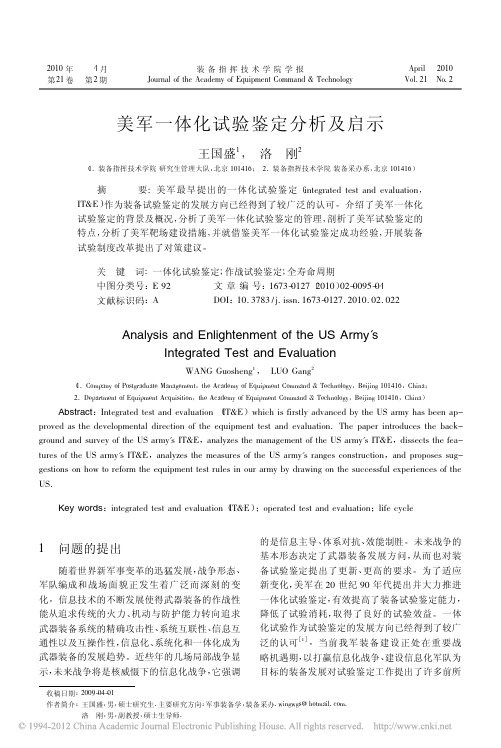
一体化试验鉴定强调减少冗余,充分利用每 次试验机会,避免重复,以减少试验消耗。美国防 部于 2008 年 12 月新发布的 DoD I5000. 2[2]中明 确要求开展一体化试验鉴定;国防采办大学出版 的《试验鉴定管理指南》[3]114-123 中特别强调了一 体化试验鉴定,要求项目主任应与用户以及试验 鉴定机构一起,将研制试验鉴定、作战试验鉴定、 实弹射击试验鉴定、系统族互操作性试验、建模和 仿真活动协调成为有效的连续体,并与要求、定义 以及系统 设 计 和 研 制 紧 密 结 合,采 用 单 一 的《试 验鉴定主计划》,形成统一和连续的活动,尽量避 免在武器研制阶段进行单一试验和重复性试验, 力争通过 1 次试验获得多个参数,以显著减少试 验资源的使用,缩短研制时间,提高试验效益。
2 美军一体化试验鉴定概况
20 世纪 90 年代,随着苏联解体、冷战结束和 美国国防政策调整,美军大幅削减装备试验鉴定 资金、人员,导致试验能力严重下滑。随着新型武 器装备的不断发展,美军认识到装备试验鉴定能 力难以满足装备发展的需要。为适应武器系统采 办发展要求,更好地发挥试验资源潜力,节约试验 鉴定经费,缩短研制周期,降低采办风险,提高试 验鉴定效率,美军提出“一 体 化 试 验 鉴 定”的 概 念,即所有试验鉴定相关机构( 尤指研制和作战 试验鉴定机构,包括承包商和政府组织) 共同合 作,对各试验阶段和各试验活动进行的计划与实 施,旨在 为 独 立 的 分 析、鉴 定 和 报 告 提 供 共 享 数据。
美国USCGPSCISPS检查要点(二)

美国USCGPSCISPS检查要点(二)B. 甲板/生活区的检查检查官通常在大副陪同下,巡视甲板,甲板的总体印象会影响到检查的深入程度。
对某些细小的缺陷,如陪同人员能合理地解释,通常能被接受。
船体,主甲板,舱口围,通风筒的开关及水密,栏杆/弦墙,主消防管系及分隔阀,舱盖的水密部件,开关舱油压系统是否漏油,引水梯及照明灯状况等都是检查的重点。
特别是水密部件是否有效,能否正常关闭,压载舱的透气口是经常出现缺陷纪录的项目,要船方抵港前加强自检,有问题及早解决。
救生/消防设备的检查也是在甲板巡查中进行的,如救生艇/救助艇的外观及标志,救生/救助艇的进一步检查通常会在救生演习中进行,若不进行演习,则会在甲板巡视中进行下列项目检查:机动艇(艇机启动,进倒车,左右舵),非机动艇(浆或推进装置的使用状况),所有艇(艇具齐全,罗经及照明工作正常,救生信号/救生干粮在有效期内,核实松放/回收装置/限位开关的有效性,若检查官对设备的功效有疑问,通常会要求放艇,钢丝是否两年半掉头/五年换新);救生筏的布置/检验日期/操纵绳的系绑,救生集结地点标志/操作说明是否清晰易读,救生圈的数量/布置/标志,自亮灯是否工作;生活区外的防火控制图的存放是否符合规定,通岸接头是否完整,消防员装备的状况/数量和存放,便携式灭火器的布置/检验,大型灭火装置(CO2等)的通风/连接管以及船员对该设备的熟悉程度;油漆间的通风/开关绝缘/固定灭火装置的工作状况;防油污设备/油柜透气口铜网及防漏箱的放水拴工作状况,若恰逢加油,要张贴严禁烟火标志/挂B旗/有加油前会议记录,有合适的通讯设备,跑油报告程序和包括船员通晓文字的驳油/平仓操作说明。
USCG检查生活区时,会查看防火门是否被绑住(除非船舶配备火警自动闭门装置,否则要处于常闭状态),生活区内的通风/照明情况,通常要求检查厨房/餐厅和2-3个普通船员房间,查看卫生状况,冰箱,冷热水,冰库以及冰库防锁警报系统,察看个人救生设备的情况,救生衣的标志/灯/哨是否齐全,是否有保温服,存放柜是否有明显带荧光的标志,个人生活设施是否符合ILO的要求,检查医生房/药房,卫生间内花洒/冲水马桶是否工作等,不要在走/梯道堆放物品,不恰当的物品堆放也是一项缺陷。
GMDSS实操题卡口述题参考答案
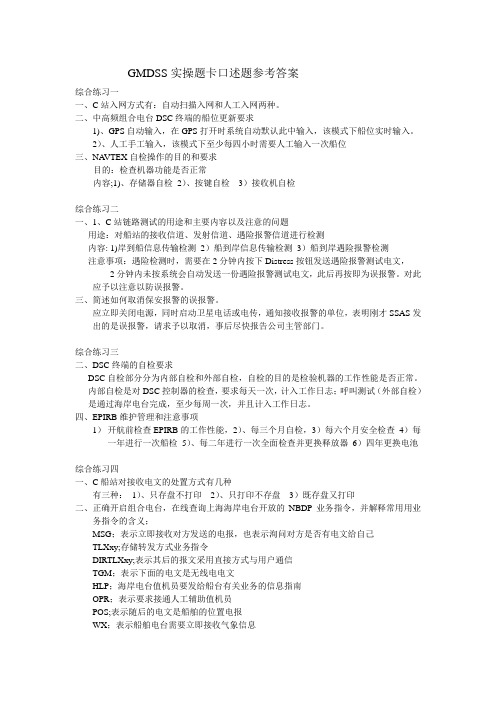
GMDSS实操题卡口述题参考答案综合练习一一、C站入网方式有:自动扫描入网和人工入网两种。
二、中高频组合电台DSC终端的船位更新要求1)、GPS自动输入,在GPS打开时系统自动默认此中输入,该模式下船位实时输入。
2)、人工手工输入,该模式下至少每四小时需要人工输入一次船位三、NA VTEX自检操作的目的和要求目的:检查机器功能是否正常内容;1)、存储器自检2)、按键自检3)接收机自检综合练习二一、1、C站链路测试的用途和主要内容以及注意的问题用途:对船站的接收信道、发射信道、遇险报警信道进行检测内容: 1)岸到船信息传输检测2)船到岸信息传输检测3)船到岸遇险报警检测注意事项:遇险检测时,需要在2分钟内按下Distress按钮发送遇险报警测试电文,2分钟内未按系统会自动发送一份遇险报警测试电文,此后再按即为误报警。
对此应予以注意以防误报警。
三、简述如何取消保安报警的误报警。
应立即关闭电源,同时启动卫星电话或电传,通知接收报警的单位,表明刚才SSAS发出的是误报警,请求予以取消,事后尽快报告公司主管部门。
综合练习三二、DSC终端的自检要求DSC自检部分分为内部自检和外部自检,自检的目的是检验机器的工作性能是否正常。
内部自检是对DSC控制器的检查,要求每天一次,计入工作日志;呼叫测试(外部自检)是通过海岸电台完成,至少每周一次,并且计入工作日志。
四、EPIRB维护管理和注意事项1)开航前检查EPIRB的工作性能,2)、每三个月自检,3)每六个月安全检查4)每一年进行一次船检5)、每二年进行一次全面检查并更换释放器6)四年更换电池综合练习四一、C船站对接收电文的处置方式有几种有三种:1)、只存盘不打印2)、只打印不存盘3)既存盘又打印二、正确开启组合电台,在线查询上海海岸电台开放的NBDP业务指令,并解释常用用业务指令的含义;MSG;表示立即接收对方发送的电报,也表示洵问对方是否有电文给自己TLXxy;存储转发方式业务指令DIRTLXxy;表示其后的报文采用直接方式与用户通信TGM;表示下面的电文是无线电电文HLP;海岸电台值机员要发给船台有关业务的信息指南OPR;表示要求接通人工辅助值机员POS;表示随后的电文是船舶的位置电报WX;表示船舶电台需要立即接收气象信息NA V;表示船舶电台需要立即接收航行警告BRK;无线拆线ABS;用户不在/办公时间已过KKKK;有线拆线DER;故障GA;请放过来MOM;梢等NCH;用户号码已改变OCC;占线RPT;重复WRU;你是谁TAX;:报费为。
先进的嵌入式训练技术在美海军中的典型应用案例
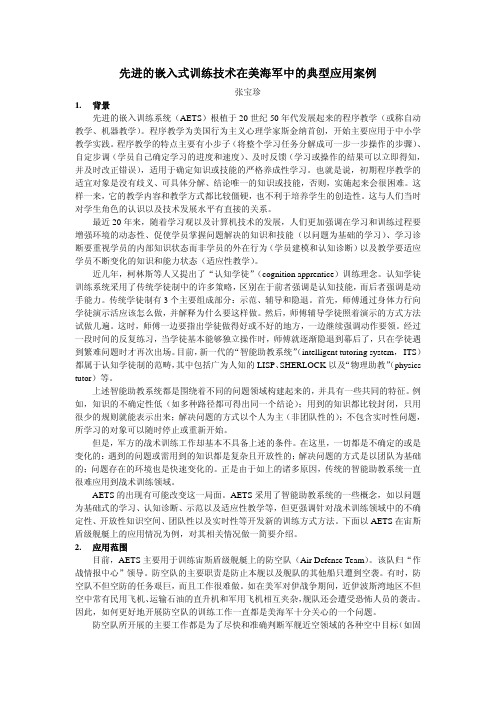
先进的嵌入式训练技术在美海军中的典型应用案例张宝珍1.背景先进的嵌入训练系统(AETS)根植于20世纪50年代发展起来的程序教学(或称自动教学、机器教学)。
程序教学为美国行为主义心理学家斯金纳首创,开始主要应用于中小学教学实践。
程序教学的特点主要有小步子(将整个学习任务分解成可一步一步操作的步骤)、自定步调(学员自己确定学习的进度和速度)、及时反馈(学习或操作的结果可以立即得知,并及时改正错误),适用于确定知识或技能的严格养成性学习。
也就是说,初期程序教学的适宜对象是没有歧义、可具体分解、结论唯一的知识或技能,否则,实施起来会很困难。
这样一来,它的教学内容和教学方式都比较僵硬,也不利于培养学生的创造性。
这与人们当时对学生角色的认识以及技术发展水平有直接的关系。
最近20年来,随着学习观以及计算机技术的发展,人们更加强调在学习和训练过程要增强环境的动态性、促使学员掌握问题解决的知识和技能(以问题为基础的学习)、学习诊断要重视学员的内部知识状态而非学员的外在行为(学员建模和认知诊断)以及教学要适应学员不断变化的知识和能力状态(适应性教学)。
近几年,柯林斯等人又提出了“认知学徒”(cognition apprentice)训练理念。
认知学徒训练系统采用了传统学徒制中的许多策略,区别在于前者强调是认知技能,而后者强调是动手能力。
传统学徒制有3个主要组成部分:示范、辅导和隐退。
首先,师傅通过身体力行向学徒演示活应该怎么做,并解释为什么要这样做。
然后,师傅辅导学徒照着演示的方式方法试做几遍。
这时,师傅一边要指出学徒做得好或不好的地方,一边继续强调动作要领。
经过一段时间的反复练习,当学徒基本能够独立操作时,师傅就逐渐隐退到幕后了,只在学徒遇到繁难问题时才再次出场。
目前,新一代的“智能助教系统”(intelligent tutoring system, ITS)都属于认知学徒制的范畴,其中包括广为人知的LISP、SHERLOCK以及“物理助教”(physics tutor)等。
GMDSS实操报告

Number of return attempts(TX)1(卫星线路识别码、船到岸方向)
Signal strength (0—very low 7—very high) 7(信号强度7为最佳)
Distress alert fail(遇险报警测试失败)
空两行
打入文件内容
发送方式同发送TELEX船位电报相同,不同的是地址薄部分传输类型为SPECIAL。
五、根据航行海区正确设置与接收EGC
CONTROL——SET UP——EGC SET UP
EGC模式:SET NORMAL MODE
安全网:EGC SAFETYNET——NAVAREA;COASTAL——写入航行警告区代码和全部NAVTEX台例如:11 A——Z(N、Q、R、L)——SET TO TRANSCEIVER——COASTAL WARNINGS——选择项目[X]YES选定NO否定;信息种类:A、B、D、L。
按格式清晰地发送遇险报告:讲完说OVER
等待RCC指示,如果RCC要你挂机,则挂机等待。
注:当发起遇险报警,船位和IMN自动发到RCC
设备名称
MF/HF组合电台
型号
IRP—1000 NBDP/SCANCOMM
操作目的
掌握设备的组成和基本操作方法及日常保养方法
操作内容
无线电话,电传通信,遇险通信,DSC通信,自检方法
将传真机设置为自动——将文件有字的一面朝下放入文件口——显示屏提示文件已放好——开始拨号——用#号发起呼叫——收到被呼方传真机应答——自动开始传真——传真完成自动挂机。
无拨号盘传真机操作:在手柄上拨号:用2nd和Fax(数字4键)代替#键。
HEC-RAS操作程序
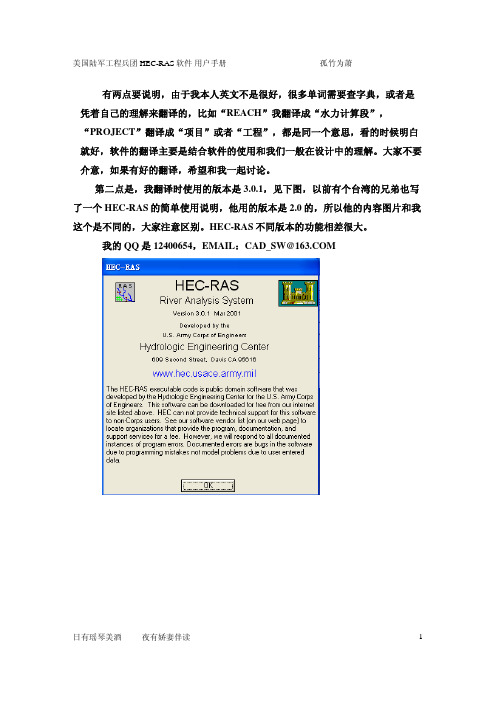
有两点要说明,由于我本人英文不是很好,很多单词需要查字典,或者是凭着自己的理解来翻译的,比如“REACH”我翻译成“水力计算段”,“PROJECT”翻译成“项目”或者“工程”,都是同一个意思,看的时候明白就好,软件的翻译主要是结合软件的使用和我们一般在设计中的理解。
大家不要介意,如果有好的翻译,希望和我一起讨论。
第二点是,我翻译时使用的版本是3.0.1,见下图,以前有个台湾的兄弟也写了一个HEC-RAS的简单使用说明,他用的版本是2.0的,所以他的内容图片和我这个是不同的,大家注意区别。
HEC-RAS不同版本的功能相差很大。
我的QQ是12400654,EMAIL:CAD_SW@第一章 介绍略。
就是欢迎大家使用,Welcome~~~~呵呵。
介绍了一下功能,主要是稳定流和不稳定流的水力分析,并且还有泥沙运动分析、水力设计功能。
第二章 软件安装略。
对我们大家经常使用D版软件的兄弟来说,安装应该不是什么问题,况且这个HEC-RAS还是正版的,呵呵。
第三章 使用HEC-RAS概述HEC-RAS是一个综合性的水力分析软件包,软件使用的是图形界面(GUI)。
能够计算稳定流、不稳定流的水面线,在将来的版本中,将包括泥沙运动和水力设计功能。
HEC-RAS的结构中,“项目”(Project)是河流系统所有计算文件和数据的集合。
建模者可以利用HEC-RAS进行各种形式的分析,分析成果作为项目的一部分。
一个“项目”的数据文件由下列数据组成:计划文件、几何数据、稳定流数据、不稳定流数据、泥沙数据和水力设计数据。
学习的过程中,可能建模者需要比较几个相似的“计划”。
每一个计划需要一套相应的几何数据和水流数据。
当基础数据输入到HEC-RAS中后,建模者可以根据这些基础数据,很容易的进行一个新的计划(而不是又重新开始一个新的模型,并且这些“计划”都在这一个“项目”中)。
这些不同的计划的结果,可以通过图或者表的形式表现出来,方便进行比较。
美国海军潜水手册

U.S.NAVY DIVING MANUAL美国海军潜水手册(Decompression sickness Treatment & Treatmentment Table)(潜水减压病及减压病治疗表部分)20 JNUARY 1999Chang A dated 1 MARCH 2001目录 MUNE水下减压停留过程中发生减压病的治疗流程 2 I型减压病的治疗(常规潜水减压病及高原暴露潜水减压病的治疗)流程 3 减压病和肺气压伤的治疗流程 4 复发性减压病的治疗流程 6 治疗表5(附分列图和简略图)8 治疗表6(附分列图和简略图)10 治疗表 6 A(附分列图和简略图)12治疗表4(附分列图和简略图)14 治疗表7(附分列图和简略图)16 治疗表8(附分列图)18 治疗表9(附分列图和简略图)20 空气治疗表 1 A(附分列图和简略图)21 空气治疗表 2 A(附分列图和简略图)23 空气治疗表3(附分列图和简略图)25是无 是是 否否诊断:治疗过程中症状复发 症状发作是在60英尺或更深的深度上吗?需要提高治疗压力吗?(注释1)诊断:治疗以后复发的减压病 治疗的方法请参照《减压病和肺气压伤》的治疗延长并/或扩延目前的治疗方案 症状是否减轻? 还需要再增加治疗深度吗?生命指标变坏(症状加重)或还需要在60英尺处停留更长的时间吗? (注释2)用治疗表6进行治疗采用治疗表6的扩延方案来治疗加压至症状消失(最大深度165英尺),在升压期间需关闭氧气在该压力下保持停留30如有治治疗表 5Treatment Table 51. 加压速率:—— 20英尺/分钟。
2. 上升速率:——不超过1英尺/分钟。
倘若上升速率慢于该速率时无需进行修正;如果上升速率过快则需通过停顿的方式来进行补偿。
3. 到达60英尺后即开始吸氧。
4. 如果在治疗过程中因为发生了急性氧中毒而停止了吸氧,则必须等中毒症状完全消退15分钟之后,且在消退症状的深度点上重新开始吸氧治疗, 请参照氧中毒处理的章节内容。
美军舰艇核生化防护训练流程

美军舰艇核生化防护训练流程下载温馨提示:该文档是我店铺精心编制而成,希望大家下载以后,能够帮助大家解决实际的问题。
文档下载后可定制随意修改,请根据实际需要进行相应的调整和使用,谢谢!并且,本店铺为大家提供各种各样类型的实用资料,如教育随笔、日记赏析、句子摘抄、古诗大全、经典美文、话题作文、工作总结、词语解析、文案摘录、其他资料等等,如想了解不同资料格式和写法,敬请关注!Download tips: This document is carefully compiled by theeditor. I hope that after you download them,they can help yousolve practical problems. The document can be customized andmodified after downloading,please adjust and use it according toactual needs, thank you!In addition, our shop provides you with various types ofpractical materials,such as educational essays, diaryappreciation,sentence excerpts,ancient poems,classic articles,topic composition,work summary,word parsing,copy excerpts,other materials and so on,want to know different data formats andwriting methods,please pay attention!美军舰艇核生化防护训练是为了提高舰员在核生化事故或攻击情况下的生存能力和应急反应能力。
何晓骁?“XR”与人工智能技术在美军“飞行员未来训练”计划中发挥作用

何晓骁¦“XR”与人工智能技术在美军“飞行员未来训练”计划中发挥作用虚拟现实(VR)、增强现实(AR)和混合现实(MR)等,被称为“XR”,这些技术已经具备了民转军的条件。
2019年11月底,洛克希德马丁公司官网发布了名为“在2020年将有三项技术应用于军事训练”的文章。
文中指出在游戏中的使用的虚拟现实、增强现实和混合现实技术的成熟度、质量和价格已经具备了在军事领域推广应用的条件。
三项即将投入军事应用的技术是:1.增强现实+按需培训美国洛马公司提供的增强现实+按需培训视频(美国洛马公司)就像网购、外卖食品、最新电影这些都可以按需交付。
军事训练领域也沿着这条路在发展任务训练技术。
仿真与增强现实眼镜相结合,提供了对武器装备维护保障训练的新手段。
最近,美国洛马公司与美海军陆战队合作对新的基于增强现实的装备维护训练进行了评估。
2.虚拟现实+多域培训美国洛马公司提供的虚拟现实+多域培训视频(美国洛马公司)在多域战场中,系统是相互连接和集成的。
2020年,F-35 Lightning II模拟器将与其他系统联网,以提供“随战而动”的虚拟环境。
随着澳大利亚运营F-35机队,该国正在构建其最大的网络模拟训练系统。
愿景是将地面模拟器与飞行中的飞机以及虚拟的友好或敌对力量集成,使训练环境更真实。
3.混合现实+交钥匙培训美国洛马公司提供的混合现实+交钥匙培训视频(美国洛马公司)军事训练主要是以人为核心的,而不仅仅是技术。
传统方法侧重于提供训练工具和设备。
如今,外军正在采用更具创新性的方法来提供高效的学习方法。
交钥匙式训练计划提供了一套包括实装、模拟器、训练计划、训练课件、教员等在内的解决方案,快速增加学员技能,缩短训练时间,降低训练成本。
澳大利亚、加拿大、英国和新加坡都采用了这种模式。
这种模式还可以集成新兴技术,例如混合现实结合了增强现实和虚拟现实的优点。
通过合并现实世界和虚拟世界,让物理和数字域可以共存并实时交互。
- 1、下载文档前请自行甄别文档内容的完整性,平台不提供额外的编辑、内容补充、找答案等附加服务。
- 2、"仅部分预览"的文档,不可在线预览部分如存在完整性等问题,可反馈申请退款(可完整预览的文档不适用该条件!)。
- 3、如文档侵犯您的权益,请联系客服反馈,我们会尽快为您处理(人工客服工作时间:9:00-18:30)。
在编程开始前要认识一下*.tga后缀的文件:
TGA格式(Tagged Graphics)是由美国Truevision公司为其显示卡开发的一种图像文件格式,文件后缀为“.tga”,已被国际上的图形、图像工业所接受。
TGA的结构比较简单,属于一种图形、图像数据的通用格式,在多媒体领域有很大影响,是计
算机生成图像向电视转换的一种首选格式。
TGA图像格式最大的特点是可以做出不规则形状的图形、图像文件,一般图形、图像文件都为四方形,若需要有圆形、菱形甚至是缕空的图像文件时,TGA可就派上用场了!
TGA格式支持压缩,使用不失真的压缩算法。
在工业设计领域,使用三维软件制作出来的图像可以利用TGA格式的优势,在图像内部生成一个Alpha(通道),这个功能方便了在平面软件中的工作。
==========================================================================
========
#include <osgViewer/Viewer>
#include <osgDB/ReadFile>
#include <osg/ref_ptr>
#include <osg/Geometry>
#include <osg/PositionAttitudeTransform>
#include <osg/Geode>
#include <osg/Group>
#include <osg/Texture2D>
#include <iostream>
using namespace std;
osg::Geode* createPyramid()
{
osg::Geode* pyramidGeode = new osg::Geode();
osg::Geometry* pyramidGeometry = new osg::Geometry();
pyramidGeode->addDrawable(pyramidGeometry);
// 指定顶点
osg::Vec3Array* pyramidVertices = new osg::Vec3Array;
pyramidVertices->push_back( osg::Vec3(0, 0, 0) ); // 左前
pyramidVertices->push_back( osg::Vec3(2, 0, 0) ); // 右前
pyramidVertices->push_back( osg::Vec3(2, 2, 0) ); // 右后
pyramidVertices->push_back( osg::Vec3( 0,2, 0) ); // 左后
pyramidVertices->push_back( osg::Vec3( 1, 1,2) ); // 塔尖
// 将顶点数组关联给几何体
pyramidGeometry->setVertexArray( pyramidVertices );
// 根据底面的四个顶点创建底面四边形(QUAD)
osg::DrawElementsUInt* pyramidBase =
new osg::DrawElementsUInt(osg::PrimitiveSet::QUADS, 0);
pyramidBase->push_back(3);
pyramidBase->push_back(2);
pyramidBase->push_back(1);
pyramidBase->push_back(0);
// 创建其他面的代码从略
osg::Vec4Array* colors = new osg::Vec4Array;
colors->push_back(osg::Vec4(1.0f, 0.0f, 0.0f, 1.0f) ); //索引0 红色
colors->push_back(osg::Vec4(0.0f, 1.0f, 0.0f, 1.0f) ); //索引1 绿色
colors->push_back(osg::Vec4(0.0f, 0.0f, 1.0f, 1.0f) ); //索引2 蓝色
colors->push_back(osg::Vec4(1.0f, 1.0f, 1.0f, 1.0f) ); //索引3 白色
osg::TemplateIndexArray
<unsigned int, osg::Array::UIntArrayType,4,4> *colorIndexArray;
colorIndexArray =
new osg::TemplateIndexArray<unsigned int, osg::Array::UIntArrayType,4,4>;
colorIndexArray->push_back(0); // 顶点0对应颜色元素0
colorIndexArray->push_back(1); // 顶点1对应颜色元素1
colorIndexArray->push_back(2); // 顶点2对应颜色元素2
colorIndexArray->push_back(3); // 顶点3对应颜色元素3
colorIndexArray->push_back(0); // 顶点4对应颜色元素0
pyramidGeometry->setColorArray(colors);
pyramidGeometry->setColorIndices(colorIndexArray); pyramidGeometry->setColorBinding(osg::Geometry::BIND_PER_VERTEX);
osg::Vec2Array* texcoords = new osg::Vec2Array(5);
(*texcoords)[0].set(0.00f,0.0f); // 顶点0的纹理坐标
(*texcoords)[1].set(0.25f,0.0f); // 顶点1的纹理坐标
(*texcoords)[2].set(0.50f,0.0f); // 顶点2的纹理坐标
(*texcoords)[3].set(0.75f,0.0f); // 顶点3的纹理坐标
(*texcoords)[4].set(0.50f,1.0f); // 顶点4的纹理坐标
pyramidGeometry->setTexCoordArray(0,texcoords);
return pyramidGeode;
}
int main()
{
// 声明场景的根节点
osg::Group* root = new osg::Group();
osg::Geode* pyramidGeode = createPyramid();
root->addChild(pyramidGeode);
osg::Texture2D* KLN89FaceTexture = new osg::Texture2D;
//避免在优化过程中出错
KLN89FaceTexture->setDataVariance(osg::Object::DYNAMIC);
// 从文件读取图片
osg::Image* klnFace = osgDB::readImageFile("KLN89FaceB.tga");
if (!klnFace)
{
printf(" couldn't find texture, quiting.");//输出错误
system("pause");
return -1;
}
// 将图片关联到纹理
KLN89FaceTexture->setImage(klnFace);
// 创建StateSet
osg::StateSet* stateOne = new osg::StateSet();
// 将纹理关联给StateSet的纹理单元0
stateOne->setTextureAttributeAndModes
(0,KLN89FaceTexture,osg::StateAttribute::ON);
// 将渲染状态关联给金字塔节点
pyramidGeode->setStateSet(stateOne);
osgViewer::Viewer viewer;
//最后我们进入仿真循环:
viewer.setSceneData( root );
return viewer.run();
}。
